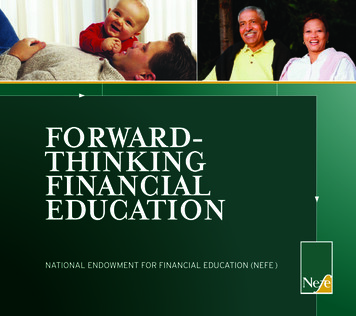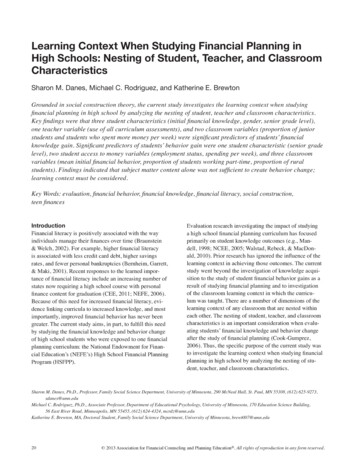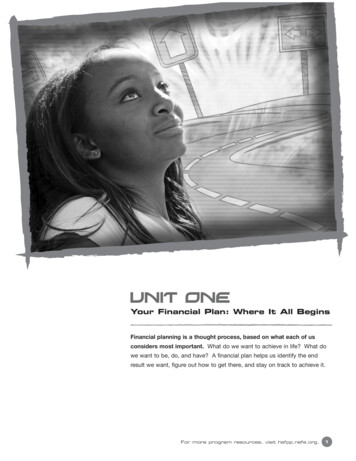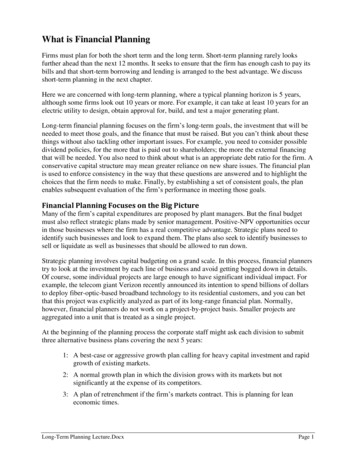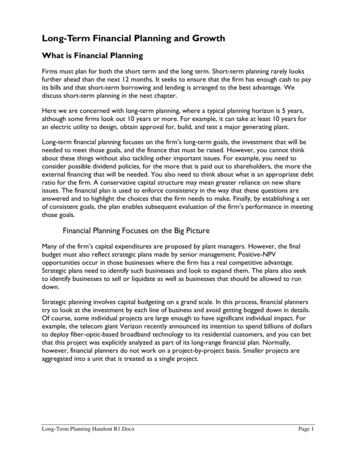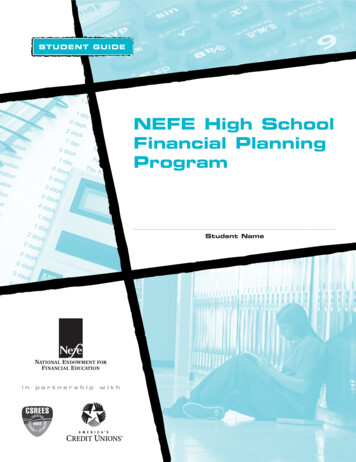
Transcription
NEFE High SchoolFinancial PlanningProgramStudent Nameinpartnershipwith
Copyright 2006, National Endowment for Financial Education (NEFE ). All rights reserved.This publication is sponsored by the National Endowment for Financial Education (“NEFE”) in partnership with theCooperative State Research, Education, and Extension Service, USDA, and participating Land-Grant UniversityCooperative Extension Services, and Credit Union National Association, Inc., and America’s Credit Unions. Thispublication is intended for use as part of the NEFE High School Financial Planning Program (HSFPP) as a publicservice to enhance the financial literacy of youth.The use of this publication is subject to the following terms. This publication may be used only as expresslypermitted by the following terms and may not be used in any way prohibited by the following terms: This publication may only be used for instructional and educational purposes as part of the NEFE HSFPP. No part of this publication may be copied or reproduced. This publication may be used only in the form provided by NEFE and may not be modified, amended, orcombined with other material. This publication may not be used for any commercial purpose, or to sell, advertise, endorse, or otherwisepromote any other service, product, or party. No separate fee or consideration may be charged in exchange for this publication or for participation in theNEFE HSFPP.NEFE intends that the content in this publication is current as of the initial release of this publication by NEFE.Following the initial release of this publication by NEFE, however, changes may have occurred to the laws,regulations, and other practices relevant to the content in this publication. Before using this publication, NEFEencourages you to confirm that the content in this release of this publication is up-to-date.The NEFE HSFPP is presented in facilities throughout the country by volunteers from the financial services industryand other industries. The facilities and instructors involved in the presentation of the NEFE HSFPP are independentfrom NEFE, and NEFE does not review, approve, sanction, or otherwise control the facilities or instructors involved inthe presentation of the NEFE HSFPP. NEFE disclaims and takes no responsibility for the performance of or anydamage or liability caused by the facilities or instructors involved in the presentation of the NEFE HSFPP.Please visit the NEFE HSFPP Web site at http://hsfpp.nefe.org. For more information about NEFE, the NEFEHSFPP, or this publication, contact NEFE at:National Endowment for Financial EducationHigh School Department5299 DTC Boulevard, Suite 1300Greenwood Village, CO 80111Phone: (303) 224-3511ABOUT THE SPONSORS OF THIS PUBLICATION:About NEFEThe National Endowment for Financial Education is an independent, nonprofit foundation dedicated to the goal ofhelping all Americans improve the quality of their lives through their acquisition of information and skills thatenable sound and knowledgeable financial decision making.About Cooperative State Research, Education and Extension Service, USDAThe Cooperative Extension System, a national educational network established through legislation, is a partnership of the Cooperative State Research, Education, and Extension Service, U.S. Department of Agriculture(CSREES, USDA), State land-grant universities, and county governments. CSREES prohibits discrimination in allits programs and activities on the basis of race, color, national origin, sex, religion, age, disability, political beliefs,sexual orientation, or marital or family status. (Not all prohibited bases apply to all programs.)About CUNAWith its network of affiliated state credit union leagues, Credit Union National Association serves more than 90percent of America's 9,000 credit unions, which are owned by more than 88 million consumer members. Creditunions are not-for-profit cooperatives providing affordable financial services to people from all walks of life. Formore information, visit www.cuna.org.
Table of ContentsIntroductioniHow to Build on What You Learn in This BookiiBeyond the Book: Your Own Web SpaceiiiUnit 1Your Financial Plan: Where It All Begins1What’s So Important About Financial Planning?3Step 1: Set SMART Financial Goals3Do You Need It or Do You Want It?3Getting SMART About Your Goals4SMART Goal Examples5Step 2: Analyze Information: Where Does Your Money Go?8Step 3: Create a Plan: Your Financial Roadmap9Making DecisionsStep 4: Implement the Plan: Making It Happen912Being a Responsible Spender12Guidelines for Sticking With Your Plan12Step 5: Monitor and Modify the Plan: Staying on Track13Adding It Up13Unit 1 Assessment: My Financial Plan14Unit 2Budgeting: Making the Most of Your Money15How Does Your Spending Measure Up?16Smart Spending16Part 1 of the Equation: Income17What’s a W-4 For?18Part 2 of the Equation: Expenses19The Most Important Expense20The 411 on Creating a Budget22Building a Budget22Keeping Track23Staying on Track24The Living Budget25Adding It Up25Unit 2 Assessment: My Personal Budget26
Unit 3Investing: Making Money Work for You27Saving Investing28The Time Value of Money30Show Me the Money!31The Price of Procrastination31The Rule of 7232Risky Business33An Array of Investment Options34Income Investments35Growth Investments36Many Baskets of Eggs38Smart, Steady Eddie38Adding It Up39Unit 3 Assessment: My Investing Plan40Unit 4Good Debt, Bad Debt: Using Credit Wisely41What Is Credit?42Common Types of Credit43The Cost of Using Credit44Credit: The Good and the Bad466 Questions to Ask When You Compare Credit47Are You Worthy?47The 4 C’s of Credit47Keeping Score With Your Credit49The Titans of Credit49Your Rights When Your Credit Report Is Wrong50Getting Your Piece of the Credit Pie50Be a Savvy Credit User52Pitfalls to Avoid With Credit53Look Out!53How to Avoid the Pitfalls53Credit-Related Record Keeping54The Dark Cloud of Debt54Bankruptcy55The Law and Order of Debt56Adding It Up57Unit 4 Assessment: My Plan to Handle Credit58
Unit 5Your Money: Keeping It Safe and SecureWho’s Who in Financial ServicesCheck In With Checking AccountsFollow the Bouncing CheckThe DNA of Debit Cards7 Signs of Smart Debit Card UseCredit Card ConfidentialAutomating Access to Your MoneySo Many Choices When Fraud Comes KnockingAdding It UpUnit 5 Assessment: Using Financial ServicesUnit 6Insurance: Protecting What You HaveAll About RiskSharing the RisksDriving Down Your CostsWhat to Keep and WhereAll About Auto InsuranceMaking Sure That You’re CoveredIf You Have an AccidentThrough the Years: Other Types of InsuranceYou Can Insure Just About AnythingThe Big PictureAdding It UpUnit 6 Assessment: My Insurance PlanUnit 7Your Career: Doing What Matters MostWhat Should Dante Do?Making Cents of Your CareerSkills: The Currency of Your CareerGetting Educated About EducationEducation Funding OptionsBeyond Salary—The Value of BenefitsOther Factors Fueling Your PaycheckBeing Your Own BossAdding It UpUnit 7 Assessment: Planning for My sary112Index115
IntroductionYou probably never thought you’d need help with figuring out how to spend your money! After all, teens spend billionsupon billions of dollars every year, so it sounds like you know how to spend those bucks.But there is much more to handling your money than just spending it. It’s just like learning to drive a car. It’s aboutmore than knowing how to turn on the engine, put the car into gear, and operate the steering wheel.There are right and wrong ways to drive cars and handle money. Do either one the wrong way, and you’ll find yourselfin very big trouble. While this book won’t teach you anything about driving, it can give you what you need to knowright now about managing your money wisely. And if you learn these lessons well, you’ll find you have something thatwill pay off for you for the rest of your life!When it comes to managing money, there are three types of people. People Who Just Get By. First, there are people who just live on what they make. They can’t savebecause they spend everything they get, and they try to make the money last until the next payday. Theypay their bills on time, so they don’t get into big trouble. But with no money left to save, they probablywon’t end up getting many of the bigger things they want from life. These people usually make it to theend of their careers without having much to show for it, and having given up on getting many of thethings they might otherwise have wanted. The Big Spenders. Then there are people who spend lots more than they earn. They end up owing somuch money that they can end up in serious financial trouble. People in this category often haveemployment, marriage, and health problems that complicate their lives even more. Their total lack ofunderstanding about how to handle money usually dooms them to a life of serious debt, bankruptcy, andsometimes even worse. People Who “Get It.” Finally, there are the people who really “get it.” These people know how to planand save for things. They know the difference between needs and wants and know how to get the mostout of the money they have. When they need to borrow for really big things, like a car, they will get loansat the best rates. And they will never borrow any more than they can afford to repay.People who “get it” know how to use all the services of financial institutions like banks and credit unionsto their advantage, and they realize that they need to protect what they have by insuring it. Finally, theywill choose a career or job that is fulfilling and will also support their financial needs without ever havingto go into serious debt.The goal of this book is to make you one of those people who “get it.” The sad truth is that many millions ofAmericans fit into those first two categories, and far too few fall into the last one.People who “get it” with their money are happier and more likely to get everything they want out of life.If you take to heart everything that this book has to teach, you will be solidly on the path toward being one of thosepeople who “get it” about money.iIntroduction
How to Build on What You Learn in This BookLearning to manage your money well comes with study and practice. If you successfully complete the lessons in thisbook, you’ll be setting solid goals, understanding your needs and wants, creating a plan for spending your money,and much more. You’ll have a good idea of how your job and career choices relate to how much money you’ll havefor the lifestyle you want, and you’ll be well on your way to knowing how insurance fits into your plans. And that’s asgood a start as anyone needs.To make sure you get the most out of this Student Guide, you’ll want to take careful note of several tools that arefound throughout the book: Unit Overview—At the beginning of each unit, your teacher should hand out a unit overview. This handyone-pager tells what the unit is about, how you will be able to use this information in your life, and all the otherthings you will learn along the way. Finally, it will spell out how you will know when you have succeeded inmastering what the unit is teaching. “In this unit, you will ”—At the beginning of every unit is a highlighted box telling you what you’ll learnin that unit. “What Do You Think?”—In each unit, you’ll have a chance to take some time out to learn some relevantfacts and figures about the topic at hand and why the topic is so important. “Did You Know?”—This feature gives you even more information about atopic you are studying. Look for some surprises! Highlighted Words—Every time you see a word that is highlighted,that’s a key term that you should take note of. When it is highlighted,it is also defined. At the end of the book, you’ll find a completeglossary of all these highlighted terms. “Try It!” Exercises—Be sure to complete all of the “Try It!”exercises in each unit. These will help you begin to “get yourarms around” what the unit is all about. “You Can Do It!” Assignments—The assignments in eachunit take the exercises and reading you have been doingto stretch your understanding even more. Be sure todo them all. Unit Assessments—This is where you get to showthat you really understand what the unit has beenall about. It is also where you will take what youhave learned and start to apply it to your own life.To learn more, visit hsfpp.nefe.org.ii
Beyond the Book: Your Own Web SpaceWe hope you’ll want to go even further than this book takes you. To do that, we have created a place on the Internetfor you. There you will find articles, tools, ideas, and games related to every unit in this book. At the end of eachunit, you will see a reminder to visit hsfpp.nefe.org. Once there, you’ll find many ways to help you increase yourknowledge and begin to apply all the skills this program teaches. And consider signing up for free newsletter updatesbecause there will always be new things being added to this site.Here is how to get there.1Go to hsfpp.nefe.org. That will take you to ourMain home page. To get to your page, click onthe “Students” link at the top of the home page.2That will bring you to the student’s page.When you get to the site, take some time to look around and see what’s there. You’ll find many tools related to the units of this book, along with articles on financial topics you’re probably already thinking about orwill be thinking about soon. You’ll find eight games to play, each of which will test what you are learningabout money. The site also links to many other features, including calculators to help you begin to “run thenumbers” to calculate the cost of various types of financial transactions. During and beyond the time youare studying the HSFPP, you should find this to be a very helpful tool to help you get your feet on theground around this important area of money.iiiIntroduction
National Endowment for Financial Education High School Department 5299 DTC Boulevard, Suite 1300 Greenwood Village, CO 80111 Phone: (303) 224-3511 ABOUT THE SPONSORS OF THIS PUBLICATION: About NEFE The National Endowment for Financial Education is an independent, nonprofit foundation dedicated to the goal of
